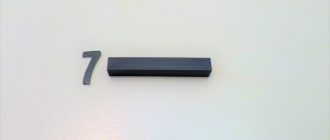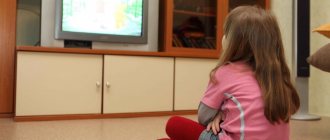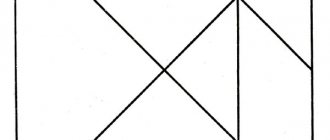Stage 1: kids play
Children 2-3 years old are unlikely to rack their brains over the problem of how to make a square out of..... They need games of a different kind, namely laying out figures, objects, and even better, fairy tales from matches.
We felt comfortable playing at a low coffee table (we have it reserved for children's creativity and games). So, we pour a few packs of matches into the middle and begin the story. For example, like this:
Once upon a time there lived a hedgehog
He had his own house
One day he met a snake
The snake lived in the thick grass
And so on: tell us about how they became friends, met a horse, a man, tried to climb a tree, and why the hedgehog didn’t succeed. The child will definitely get involved if you don’t touch him, but it’s just interesting to create, tell and build. A little time will pass and you will already be listening to fairy tales performed by your child.
Games with counting sticks in kindergarten
Methodological guide for kindergarten: “Lay out from counting sticks”
Didactic game with counting sticks for children 3 - 7 years old
Didactic game with counting sticks for preschool children
Author: Verkhoturova Lyubov Mikhailovna, additional education teacher of the first qualification category, MBOU Dubininskaya secondary school No. 13, Krasnoyarsk region, Sharypovsky district, Dubinino village Description: the work is intended for preschool children, will be of interest to everyone who loves children and knows how to unleash the child’s creative abilities in any work. Purpose: this material is recommended for preschool teachers and loving parents. Integration of educational areas: “Socialization”, “Artistic creativity”, “Health”, “Communication”, “Cognition”. Goal: development of fine motor skills of fingers in children. Objectives: Educational: -create a game environment, consolidate knowledge of colors, counting. Developmental: - develop sensory abilities; — develop constructive skills, coordination of movements; - develop creative imagination and fantasy. Educational: -to develop skills of cooperation, mutual assistance, goodwill; - to cultivate perseverance, independence in work, the ability to name what is drawn in the picture. Materials: counting sticks of different colors, cards for each child with images of familiar objects, a magic box. “Preschool teacher, educate yourself, children learn by imitating” Makarenko. Progress of the game: I. Intrigue. Educator: What do I have in my hands? Children: Box. Educator: What do you think? What's in it? Children: Beads, rings, threads, buttons. Educator: But you didn’t guess, there are objects in the box, they are thin, multi-colored, long, hard, they can be counted, now have you guessed what’s in there? Children: Pencils, twigs, counting sticks. Educator: Yes, there are counting sticks in the box, why do you think we need them, what will we do with them? Children: Play, count. Educator: That's right, we will not only count them, but also lay out drawings from them. II. Carrying out the game. Educator: I have pictures, tell me what is shown on them. Children name the pictures. Educator: Lay out a drawing from counting sticks, choosing the right color; you need to take the sticks one at a time from the box. Children complete the task. Children 3-5 years old place sticks directly on the drawing, children 6-7 years old look at the picture and lay it out on their own. You can offer to come up with your own drawing. If the child has laid out everything correctly, the teacher praises him, asks how many sticks were needed and offers to post another picture. At the end of the game, children say whether their comrades completed the task correctly. III. The result of the game.
Educator: Guys, what did we do today? Children: They laid out a pattern from sticks, drew with sticks, counted sticks, matched sticks by color, named pictures. Educator: Did you like playing with sticks? Children: Yes! Educator: Well done, you all quickly completed the task and posted beautiful drawings. 1.Sunny.
2.Truck.
3.Ship.
4.Vase.
5.Girl.
6. Christmas tree.
7.Fish.
7.Two Christmas trees.
9.Star.
10. Hedgehog.
11. Airplane.
12. Steam locomotive.
13. Flags.
14.Ladybug.
15.Boy.
16.House with a tree.
17.TV.
18.A dragonfly flies to a flower.
19.Rocket.
20.Candy.
We develop motor skills and play with counting sticks. We fix the colors, the activity is simply beautiful.
We recommend watching:
Didactic game for children from 1 to 5 years old “Family Hobbies” Do-it-yourself outdoor game “Fishing” for kindergarten Scenario of dance entertainment for children 5-7 years old Master class. Making juggling rings
Similar articles:
Games in kindergarten for children from 3 to 5 years old
Educational game in the preparatory group of kindergarten
Ball games for children 5-6 years old at home with parents
The simplest "preparatory" games
1. Make 2 triangles from 5 matches
2. Add one match to make 2 squares. (More difficult option: Add one match to make 3 quadrangles)
3. Rearrange one match so that the hare’s chair turns towards the cabbage
4. How many squares are there? What about rectangles? Is a square a rectangle?
5. Add 2 matches to make 3 squares
6. Add one match to make 3 triangles
7. Turn the tracks in the opposite direction by rearranging 4 matches
8. There is a carrot in the basket. Arrange 2 matches so that the carrot is under the basket
9. Make the letter H into the letter P by moving one match
Cuisenaire rods: description of the methodology, history and purpose of creating counting exercises
In 1952, a mathematical manual for preschoolers and primary schoolchildren was published. It was created by the Belgian mathematician George Cuisenaire. During learning, a child uses all his senses, so the method is based on the tactile mastery of some mathematical abstract concepts - orderliness, set, identity.
A colleague of the Belgian mathematician, the French scientist and philosopher Caleb Gateno, made this manual popular and for the first time began using colored counting sticks to teach children mathematics and various languages. A child, mastering one science, simultaneously develops other abilities. He will be able to identify logical connections in speculative concepts, learn to use imagination and abstract thinking.
The Cuisenaire rod technique has several goals:
- The child develops a specific counting system;
- the concept of larger and smaller numbers develops;
- skills of addition and subtraction, multiplication and division appear;
- children distinguish between the right and left sides, learn to determine the middle;
- creativity, creative inclinations, modeling and design skills develop;
- cognitive character, visual and effective methods of thinking are manifested, all types of attention are sharpened, the environment is perceived in more detail;
- fine motor skills of the hands improve.
The age for starting classes is determined individually, it depends on the development of the child. But usually the first lessons are given to three-year-old children. Although some teachers advise developing them from the age of one, teaching them to solve mathematical problems with colored sticks.
Making your own counting sticks
The set contains parallelepipeds ranging in size from 10 to 1 cm; they differ in color and material from which they are made. There are also instructions for colored Cuisenaire counting sticks, templates for different numbers and a manual with recommendations and a list of steps, tasks and examples. The lengths of the bars indicate numbers, and the colors indicate their classes.
The longer the stick, the larger the number; each centimeter adds one. Groups and classes are divided by shade: red - numbers that are multiples of two, green and blue are divided by three, units are indicated by white, and divisible by 5 and 10 - orange and yellow. The classic collection contains 241 sticks, but for preschoolers they produce simplified sets of 119 or 144 blocks. In some models, green is replaced by blue or purple, and red by pink.
Parents do not have to purchase a ready-made set; they can make it themselves. Sticks are made from wooden blocks or colored cardboard. The first option will allow the child to navigate not only by the shades and length of the product, but also by its volume. On the Internet you can find a table of the sizes of each block, as well as stencils and templates. They are printed and used to cut out sticks from the selected material. Wooden sticks are coated with a layer of acrylic paint in a tone corresponding to the class of numbers.
It is advisable to write numbers on cardboard products, so children will remember them faster. If classes are conducted using a magnetic board, then small magnets are also attached to the back of the blocks. Pre-prepare a box for storage. It should have different sections for each color of stick. After lessons, the child will independently arrange the blocks into the appropriate cells. This will help develop self-discipline and teach your child order.
Games for 4-5 years old
From the age of four, mathematical problems are added. Lessons become more meaningful and goals become more specific. Examples of tasks:
- move two white sticks together and ask the child to find one that is equal in length to the line formed;
- call the numbers out loud in order, and the baby says the corresponding color;
- The student must find blocks with numbers and lay them out in ascending or descending order.
It is advisable to use cardboard colored cards with numbers for training. Their shade should match the blocks. With their help, children will learn to correlate sizes and colors with visual images.
At the age of five, a child should be engaged in full-fledged mathematical problems. The adult asks questions, and the child must answer them by showing the appropriate sticks. Ask children about the difference in block lengths. Then begin exercises on multiplying and dividing numbers. At this time, use classic problems with fruits and vegetables.
In addition to mathematical operations, the Cuisenaire method for preschoolers allows you to learn languages:
- place emphasis with chopsticks on sheets of paper with printed words;
- build a rhythmic scheme of sentences - use sticks to indicate punctuation marks;
- using letter cubes to divide words into syllables;
- They do a syntactic analysis of the sentence, using colors to indicate different members - subject and predicate, object and participial phrases.




